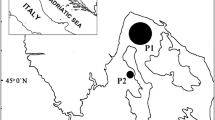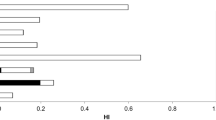Abstract
Seafood and especially mollusks are known to be a rich source of cadmium (Cd), but little data are available concerning French seafood contamination and Cd exposure of French populations. The objective was then to assess food intake and biological level of Cd in high consumers of seafood, and to determine the impact of the consumption of self-fished mollusks on urinary Cd. Seafood consumption levels of 80 products were assessed for 1011 high consumers aged 18 and over in four French coastal areas, thanks to a validated food frequency questionnaire (FFQ). According to a total diet study approach, seafood samples were collected taking into account preservation methods and supply habits. Food samples were analyzed for Cd. Exposure was assessed by crossing consumption data with contamination data. Total blood and urine samples were collected from 380 subjects of the cohort and analyzed for Cd. The impact of the self-collected mollusks consumption on the Cd biological level adjusted for creatinine was assessed by a multivariate linear regression model. The mean dietary intake of Cd is 2.44±3.34 μg/kg bw/wk and the mean urinary Cd (U-Cd) level is 0.65±0.45 μg/g creatinine, and is significantly higher in women than in men (P<0.05). The consumption of self-fished mollusks is significantly negatively associated with U-Cd (r=−0.11 [−0.185, −0.009], P=0.03). The results of this study indicate that the biological Cd levels remain below the standards, and also suggest a protective effect of self-fishing, which inspires confidence about the high consumer health safety in terms of Cd exposure.
This is a preview of subscription content, access via your institution
Access options
Subscribe to this journal
Receive 6 print issues and online access
$259.00 per year
only $43.17 per issue
Buy this article
- Purchase on Springer Link
- Instant access to full article PDF
Prices may be subject to local taxes which are calculated during checkout

Similar content being viewed by others
References
AFSSA. Etude de faisabilité d'une enquête sur les “modes d'approvisionnement locaux en produits de la mer chez des forts consommateurs”: évaluation de l'exposition aux métaux lourds et quantification du risque sanitaire associé. Note technique OCA/NB/JLV/2003–574 2003.
ATSDR. Toxicological Profile for Cadmium. Department of Health and human Services, Public Health Service, Agency for Toxic Substances and Disease Registry, 1999. Available: http://www.atsdr.cdc.gov/toxprofiles/tp5.html.
Benjamini Y., and Hochberg Y. Controlling the false discovery rate: a practical and powerful approach to multiple testing. J Roy Stat Soc 1995: 57: 289–300.
Berglund M., Akesson A., Nermell B., and Vahter M. Intestinal absorption of dietary cadmium in women depends on body irons store and fiber intake. Environ Health Perspect 1994: 102(12): 1058–1066.
Decloître F. La part des différents aliments dans l'exposition au plomb, au cadmium et au mercure, en France. Cah Nutr Diet 1998: 33(3): 167–175 (in French).
Direction Générale de la Santé (DGS). Etude sur la teneur en métaux dans l'alimentation. La diagonale des métaux, Paris 1992.
Efron B. Bootstrap Methods: Another Look at the Jackknife. Ann Statist 1979: 7(1): 1–26.
European Commission. Commission Regulation (EC) No 1881/2006 Setting Maximum Levels for Certain Contaminants in Foodstuffs, 2006.
Flanagan P.R., McLellan J., Haist J.S., Cherian G., Chamberlain M.J., and Valberg L.S. Increased dietary cadmium absorption in mice and human subjects with iron deficiency. Gastroenterology 1978: 74: 841–846.
Frery N., Nessmann C., Girard F., Lafond J., Moreau T., Blot P., et al. Environmental exposure to cadmium and human birthweight. Toxicology 1993: 79(2): 109–118.
Groten J.P., Sinkeldam E.J., Luten J.B., and van Bladeren P.J. Cadmium accumulation and metallothionein concentrations after 4-week dietary exposure to cadmium chloride or cadmium–metallothionein in rats. Toxicol Appl Pharmacol 1991: 111(3): 504–513.
Groten J.P., Luten J.B., and van Bladeren P.J. Dietary iron lowers the intestinal uptake ok cadmium–metallothionein in rats. Eur J Pharmacol 1992: 228(1): 23–28.
Heitland P., and Köster H.D. Biomonitoring of 30 trace element in urine of children and adults by ICP-MS. Clin Chim Acta 2006: 365: 310–318.
INRS. Biotox. Inventaire des laboratoires effectuant des dosages biologiques de toxiques industriels. Available: http://www.inrs.fr, 2005 (in French).
INSEE (Institut National de la Statistique et des Études Économiques). Recensement de la population française, Mars 1999 Available: http://www.recensement.insee.fr/RP99/rp99/page_accueil.paccueil, 1999.
Jarup L., Hellstrom L., Alfven T., Carlsson M.D., Grubb A., Persson B., et al. Low level exposure to cadmium and early kidney damage: the OSCAR study. Occup Environ Med 2000: 57(10): 668–672.
JECFA. Safety evaluation of certain food additives and contaminants. 33rd Report of the Joint FAO/WHO Expert Committee on Food Additives and Contaminants. WHO Technical Report Series 776. WHO, Geneva, 1989.
JECFA. Safety evaluation of certain food additives and contaminants. 55th Report of the Joint FAO/WHO Expert Committee on Food Additives and Contaminants. WHO, Rome, 2001.
JECFA. Safety evaluation of certain food additives and contaminants. 61st Report of the Joint FAO/WHO Expert Committee on Food Additives and Contaminants. WHO, Geneva, 2004.
Kikuchi Y., Nomiyama T., Kumagai N., Dekio F., Uemura T., Takebayashi T., et al. Uptake of cadmium in meals from the digestive tract of young non-smoking Japanese female volunteers. J Occup Health 2003: 45(1): 43–52.
Komaromy-Hiller G., Ash K.O., Costa R., and Howerton K. Comparison of representative ranges based on US patient population and literature reference intervals for urinary trace elements. Clin Chim Acta 2000: 296: 71–90.
Kowal N.E. Urinary cadmium and beta 2-microglobulin: correlation with nutrition and smoking history. J Toxicol Environ Health 1988: 25(2): 179–183.
Leblanc JC, Coordinator. CALIPSO. Fish and Seafood Consumption Study and Biomarker of Exposure to Trace Elements, Pollutants and Omega 3, 2006 Available: http://www.afssa.fr/ftp/afssa/38719-38720.pdf.
Leblanc J.C., Guérin T., Noël L., Calamassi-Tran G., Volatier J.L., and Verger P. Dietary exposure estimates of 18 elements from the 1st French Total Diet Study. Food Addit Contam 2005a: 22(7): 624–641.
Leblanc J.C., Malmauret L., Guérin T., Bordet F., Boursier B., and Verger P. Estimation of the dietary intake of pesticide residues, lead, cadmium, arsenic and radionuclides in France. Food Addit Contam 2000: 17(11): 925–932.
Leblanc J.C., Tard A., Volatier J.L., and Verger P. Estimated dietary exposure to principal food mycotoxins from the 1st French Total Diet Study. Food Addit Contam 2005b: 22(7): 652–672.
Moon C.S., Zhang Z.W., Shimbo S., Watanabe T., Lee C.U., Ahn K.D., et al. Evaluation of urinary cadmium and lead as markers of background exposure of middle-aged women in Korea: dietary intake as an influential factor. Toxicol Lett 1999: 108(2–3): 173–178.
Muller L., Abel J., and Ohnesorge F.K. Absorption and distribution of cadmium (Cd), copper and zinc following oral subchronic low level administration to rats of different binding forms of cadmium (Cd–acetate, Cd–metallothionein, Cd–glutathione). Toxicology 1986: 39(2): 187–195.
Nixon D.E., and Moyer T.P. Routine clinical determination of lead, cadmium and thallium in urine and whole blood by inductively coupled plasma mass spectrometry. Spectrochim Acta B 1996: 51: 13–25.
Noël L., Guérin T., and Kolf-Clauw M. Subchronic dietary exposure of rats to cadmium alters the metabolism of metals essential to bone health. Food Chem Toxicol 2004: 42(8): 1203–1210.
Nogawa K., Honda R., Kido T., Tsuritani I., Yamada Y., Ishizaki M., et al. A dose–response analysis of cadmium in the general environment with special reference to total cadmium intake limit. Environ Res 1989: 48(1): 7–16.
Olsson I.M., Bensryd I., Lundh T., Ottosson H., Skerfving S., and Oskarsson A. Cadmium in blood and urine—impact of sex, age, dietary intake, iron status, and former smoking—association of renal effects. Environ Health Perspect 2002: 110(12): 1185–1190.
Omarova A., and Phillips C.J.C. A meta-analysis of literature data relating to the relationships between cadmium intake and toxicity indicators in humans. Environ Res 2007: 103: 432–440.
Oskarsson A., Widell A., Olsson I.M., and Grawe K.P. Cadmium in food chain and health effects in sensitive population groups. Biometals 2004: 17(5): 531–534.
Satarug S., and Moore M.R. Adverse health effects of chronic exposure to low-level cadmium in foodstuffs and cigarette smoke. Environ Health Perspect 2004: 112(18): 1099–1103.
Schramel P., Wendler I., and Angerer J. The determination of metals (antimony, bismuth, lead, cadmium, mercury, palladium, platinum, tellurium, thallium, tin and tungsten) in urine samples by inductively coupled plasma mass spectrometry. Int Arch Occup Environ Health 1997: 69: 219–223.
Sirot V., Oseredczuk M., Bemrah-Aouachria N., Volatier J.-L., and Leblanc J.C. Lipid and fatty acid composition of fish and seafood consumed in France: CALIPSO study. J Food Comp Anal 2007: doi:10.1016/j.jfca.2007.05.006.
Staessen J.A., Buchet J.P., Ginucchio G., Lauwerys R.R., Lijnen P., Roels H., et al. Public health implications of environmental exposure to cadmium and lead: an overview of epidemiological studies in Belgium. Working Groups. J Cardiovasc Risk 1996: 3(1): 26–41.
Tallkvist J., Bowlus C.L., and Lonnerdal B. DMT1 gene expression and cadmium absorption in human absorptive enterocytes. Toxicol Lett 2001: 122: 171–177.
Telisman S., Cvitkovic P., Jurasovic J., Pizent A., Gavella M., and Robic B. Semen quality and reproductive endocrine function in relation to biomarkers of lead, cadmium, zinc, and copper in men. Environ Health Perspect 2000: 108(1): 45–53.
Tressou J., Crépet A., Bertail P., Feinberg M.H., and Leblanc J.C. Probabilistic exposure assessment to food chemicals based on extreme value theory. Application to heavy metals from fish and sea products. Food Chem Toxicol 2004: 42: 1349–1358.
Vahter M., Berglund M., Nermell B., and Akesson A. Bioavailability of cadmium from shellfish and mixed diet in women. Toxicol Appl Pharmacol 1996: 136(2): 332–341.
WHO/ANFZA/FAO. Total Diet Studies (TDS). Consultation ANFZA/WHO/FAO, Brisbane, Australia. Available: 〈http://www.who.int/foodsafety/publications/chem/tds_feb2002/en/index.html〉 2002.
WHO/IARC. Monographs on Evaluation of Carcinogenic Risks to Humans. WHO, Lyon, 1993: 85: 119.
WHO/INRA. Total Diet Studies (TDS). Consultation INRA/WHO, Paris, France, Available: 〈http://www.who.int/foodsafety/publications/chem/tds_paris04/en/index.html〉 2004.
WHO/IPCS. International Programme on Chemical Safety/Gems/Food Euro Workshop on Reliable Evaluation of Low Level Contamination of Food. Federal Republic of Germany, Kulmbach, 1995.
WHO/US. FDA. Total Diet Studies (TDS). Consultation US FDA/OMS, Kansas city, MO, USA, Available: 〈http://www.who.int/foodsafety/publications/chem/tds_aug1999/en/index.html〉 1999.
Xu B., Chia S.E., Tsakok M., and Ong C.N. Trace elements in blood and seminal plasma and the relationship to sperm quality. Reprod Toxicol 1993: 7(6): 613–618.
White M.A., and Sabbioni E. Trace element reference values in tissues from inhabitants of the European Union. X. A study of 13 elements in blood and urine of a United Kingdom population. Sci Total Environ 1998: 216: 253–270.
Wilhelm M., Ewers U., and Schulz C. Revised and new reference values for some trace elements in blood and urine for human biomonitoring in environmental medicine. Int J Hyg Environ Health 2004: 207: 69–73.
Zoller H., Koch R.O., Theurl I., Obrist P., Pietrangeelo A., Montosi G., et al. Expression of the duodenal iron transporters divalent-metal transporter 1 and ferroportin 1 in iron deficiency and iron overload. Gastroenterology 2001: 120(6): 1412–1419.
Acknowledgements
We would like to thank the General Directorate for Foods of the French Ministry of Agriculture and Fisheries for its financial support, and also express our particular gratitude to all the participants in the CALIPSO survey. Thanks are also due to the Métarisk Unit from the National Institute for Agricultural Research from Paris, for its assistance in the preparation of the study protocol. Supported by a grant from the General Directorate for Foods of the French Ministry of Agriculture and Fisheries, France.
Author information
Authors and Affiliations
Corresponding author
Rights and permissions
About this article
Cite this article
Sirot, V., Samieri, C., Volatier, Jl. et al. Cadmium dietary intake and biomarker data in French high seafood consumers. J Expo Sci Environ Epidemiol 18, 400–409 (2008). https://doi.org/10.1038/sj.jes.7500615
Received:
Accepted:
Published:
Issue Date:
DOI: https://doi.org/10.1038/sj.jes.7500615
Keywords
This article is cited by
-
Cadmium and Lead Content in Chosen Commercial Fishery Products Consumed in Poland and Risk Estimations on Fish Consumption
Biological Trace Element Research (2018)
-
Fertilizer usage and cadmium in soils, crops and food
Environmental Geochemistry and Health (2018)
-
How Does Contamination of Rice Soils with Cd and Zn Cause High Incidence of Human Cd Disease in Subsistence Rice Farmers
Current Pollution Reports (2015)
-
Exposure assessment of dietary cadmium: findings from shanghainese over 40 years, China
BMC Public Health (2013)



